Capstone Project: Improving Healthcare for Native Americans (HLT-494)
VerifiedAdded on 2023/04/21
|11
|2717
|85
Project
AI Summary
This capstone project proposal focuses on improving the quality of healthcare for Native Americans through the Indian Health Services (IHS). It identifies barriers such as underfunding, rural location, and transportation issues that hinder access to quality care. The project proposes a plan involving organizational resources, stakeholders (healthcare professionals, tribal governments, and native communities), and steps for implementation, including understanding the population, reviewing activities, and prioritizing service needs. It also addresses potential barriers to implementation, such as financial deficiencies and the need for trained professionals. The evaluation process involves experienced individuals, including physicians, stakeholders, and those associated with IHS, along with tribal government backing for funding and legal support. The dissemination plan includes hiring and training staff, gathering patient feedback, sharing reports with stakeholders, and updating the Indian Health Service website with relevant information. Health educators will play a vital role in improving the quality of care, and information pamphlets will be distributed to various service units and tribal offices. The project aims to improve healthcare access, treatment, and transportation for Native Americans, particularly those in rural tribal lands.
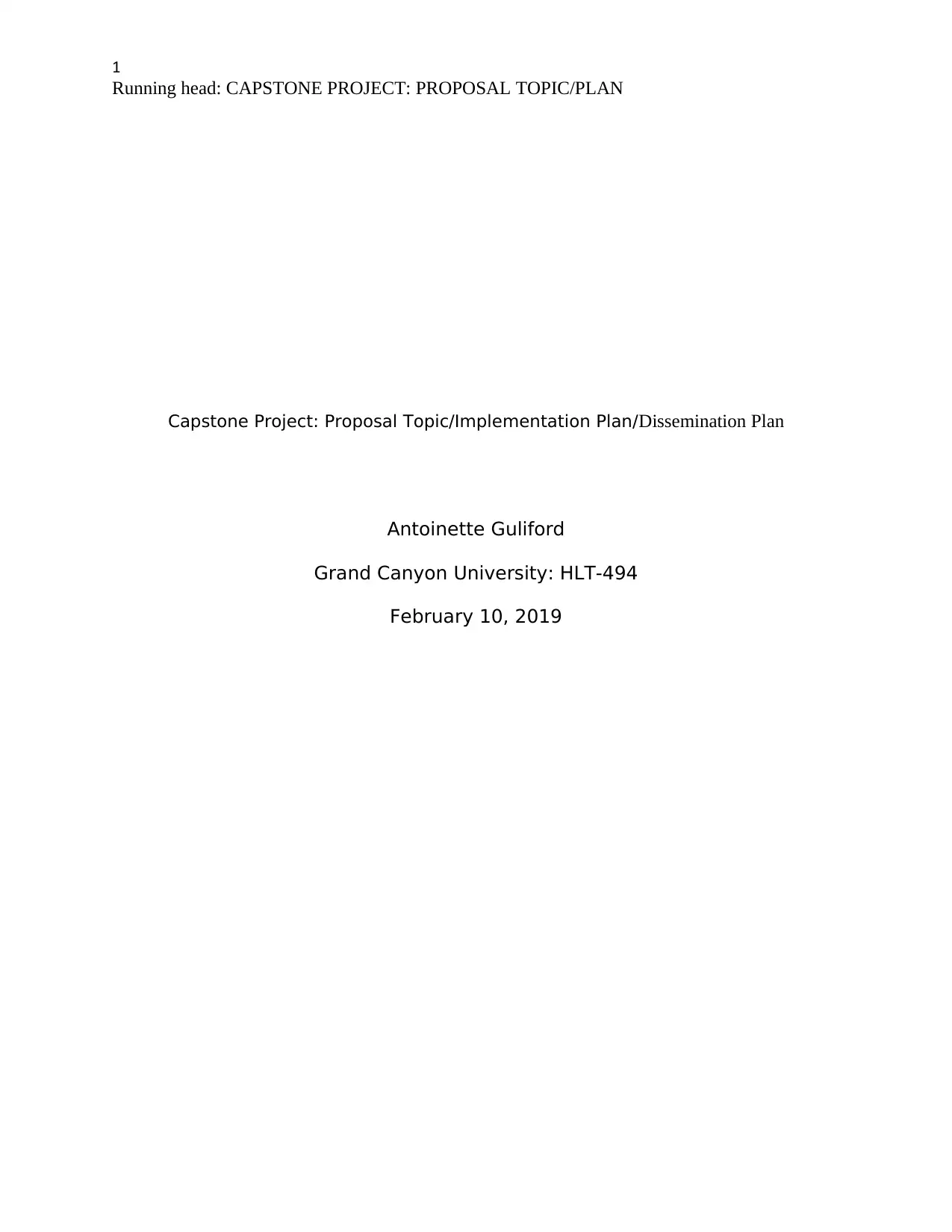
1
Running head: CAPSTONE PROJECT: PROPOSAL TOPIC/PLAN
Capstone Project: Proposal Topic/Implementation Plan/Dissemination Plan
Antoinette Guliford
Grand Canyon University: HLT-494
February 10, 2019
Running head: CAPSTONE PROJECT: PROPOSAL TOPIC/PLAN
Capstone Project: Proposal Topic/Implementation Plan/Dissemination Plan
Antoinette Guliford
Grand Canyon University: HLT-494
February 10, 2019
Paraphrase This Document
Need a fresh take? Get an instant paraphrase of this document with our AI Paraphraser
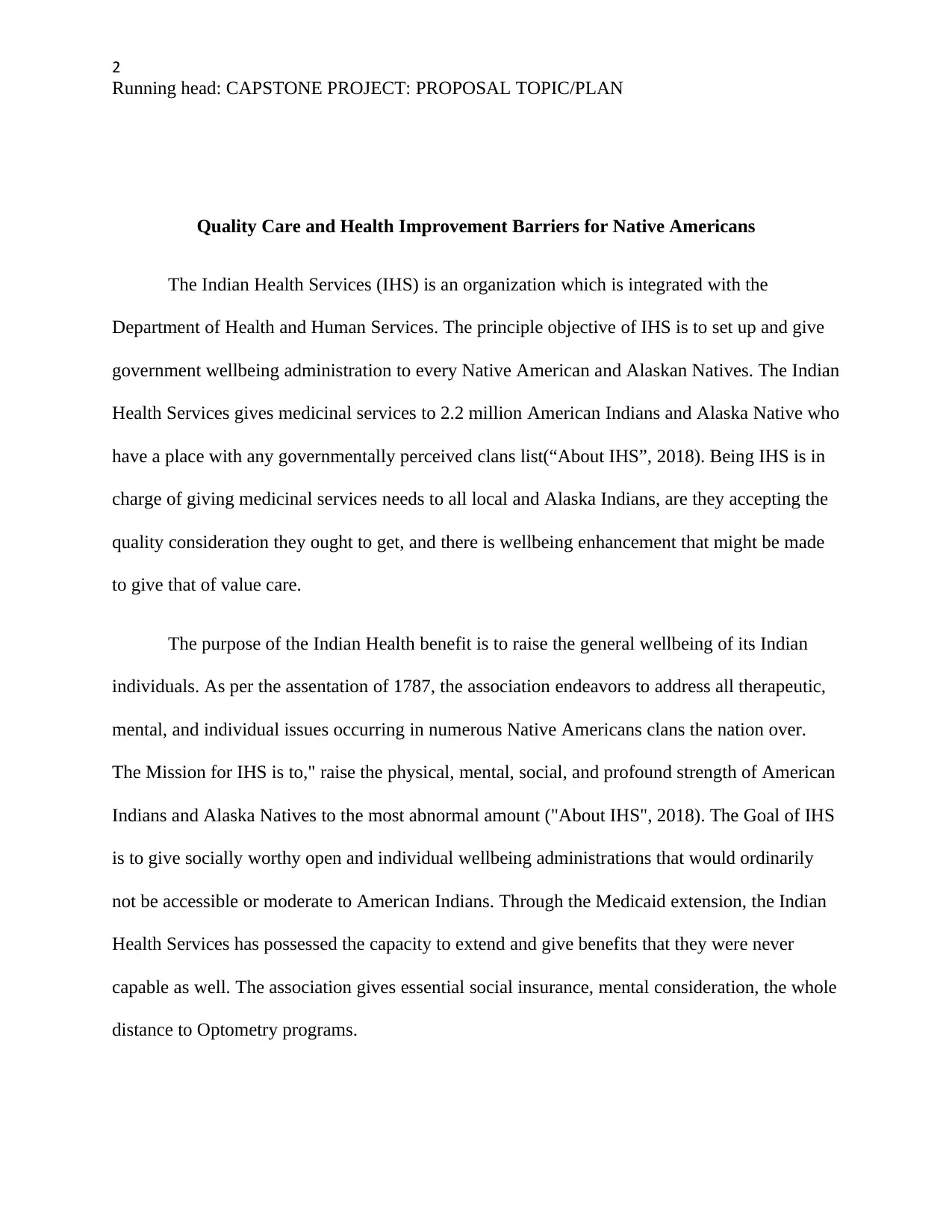
2
Running head: CAPSTONE PROJECT: PROPOSAL TOPIC/PLAN
Quality Care and Health Improvement Barriers for Native Americans
The Indian Health Services (IHS) is an organization which is integrated with the
Department of Health and Human Services. The principle objective of IHS is to set up and give
government wellbeing administration to every Native American and Alaskan Natives. The Indian
Health Services gives medicinal services to 2.2 million American Indians and Alaska Native who
have a place with any governmentally perceived clans list(“About IHS”, 2018). Being IHS is in
charge of giving medicinal services needs to all local and Alaska Indians, are they accepting the
quality consideration they ought to get, and there is wellbeing enhancement that might be made
to give that of value care.
The purpose of the Indian Health benefit is to raise the general wellbeing of its Indian
individuals. As per the assentation of 1787, the association endeavors to address all therapeutic,
mental, and individual issues occurring in numerous Native Americans clans the nation over.
The Mission for IHS is to," raise the physical, mental, social, and profound strength of American
Indians and Alaska Natives to the most abnormal amount ("About IHS", 2018). The Goal of IHS
is to give socially worthy open and individual wellbeing administrations that would ordinarily
not be accessible or moderate to American Indians. Through the Medicaid extension, the Indian
Health Services has possessed the capacity to extend and give benefits that they were never
capable as well. The association gives essential social insurance, mental consideration, the whole
distance to Optometry programs.
Running head: CAPSTONE PROJECT: PROPOSAL TOPIC/PLAN
Quality Care and Health Improvement Barriers for Native Americans
The Indian Health Services (IHS) is an organization which is integrated with the
Department of Health and Human Services. The principle objective of IHS is to set up and give
government wellbeing administration to every Native American and Alaskan Natives. The Indian
Health Services gives medicinal services to 2.2 million American Indians and Alaska Native who
have a place with any governmentally perceived clans list(“About IHS”, 2018). Being IHS is in
charge of giving medicinal services needs to all local and Alaska Indians, are they accepting the
quality consideration they ought to get, and there is wellbeing enhancement that might be made
to give that of value care.
The purpose of the Indian Health benefit is to raise the general wellbeing of its Indian
individuals. As per the assentation of 1787, the association endeavors to address all therapeutic,
mental, and individual issues occurring in numerous Native Americans clans the nation over.
The Mission for IHS is to," raise the physical, mental, social, and profound strength of American
Indians and Alaska Natives to the most abnormal amount ("About IHS", 2018). The Goal of IHS
is to give socially worthy open and individual wellbeing administrations that would ordinarily
not be accessible or moderate to American Indians. Through the Medicaid extension, the Indian
Health Services has possessed the capacity to extend and give benefits that they were never
capable as well. The association gives essential social insurance, mental consideration, the whole
distance to Optometry programs.
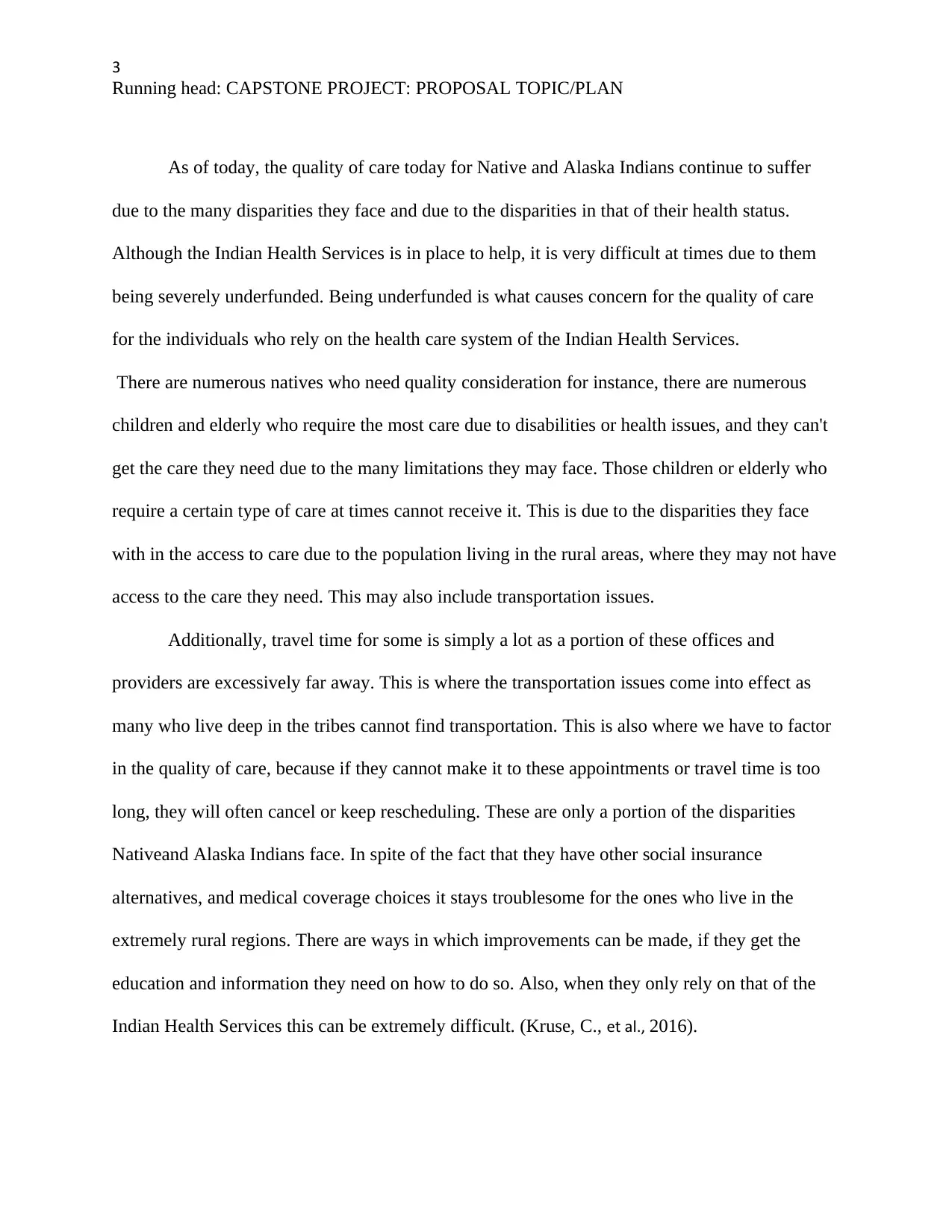
3
Running head: CAPSTONE PROJECT: PROPOSAL TOPIC/PLAN
As of today, the quality of care today for Native and Alaska Indians continue to suffer
due to the many disparities they face and due to the disparities in that of their health status.
Although the Indian Health Services is in place to help, it is very difficult at times due to them
being severely underfunded. Being underfunded is what causes concern for the quality of care
for the individuals who rely on the health care system of the Indian Health Services.
There are numerous natives who need quality consideration for instance, there are numerous
children and elderly who require the most care due to disabilities or health issues, and they can't
get the care they need due to the many limitations they may face. Those children or elderly who
require a certain type of care at times cannot receive it. This is due to the disparities they face
with in the access to care due to the population living in the rural areas, where they may not have
access to the care they need. This may also include transportation issues.
Additionally, travel time for some is simply a lot as a portion of these offices and
providers are excessively far away. This is where the transportation issues come into effect as
many who live deep in the tribes cannot find transportation. This is also where we have to factor
in the quality of care, because if they cannot make it to these appointments or travel time is too
long, they will often cancel or keep rescheduling. These are only a portion of the disparities
Nativeand Alaska Indians face. In spite of the fact that they have other social insurance
alternatives, and medical coverage choices it stays troublesome for the ones who live in the
extremely rural regions. There are ways in which improvements can be made, if they get the
education and information they need on how to do so. Also, when they only rely on that of the
Indian Health Services this can be extremely difficult. (Kruse, C., et al., 2016).
Running head: CAPSTONE PROJECT: PROPOSAL TOPIC/PLAN
As of today, the quality of care today for Native and Alaska Indians continue to suffer
due to the many disparities they face and due to the disparities in that of their health status.
Although the Indian Health Services is in place to help, it is very difficult at times due to them
being severely underfunded. Being underfunded is what causes concern for the quality of care
for the individuals who rely on the health care system of the Indian Health Services.
There are numerous natives who need quality consideration for instance, there are numerous
children and elderly who require the most care due to disabilities or health issues, and they can't
get the care they need due to the many limitations they may face. Those children or elderly who
require a certain type of care at times cannot receive it. This is due to the disparities they face
with in the access to care due to the population living in the rural areas, where they may not have
access to the care they need. This may also include transportation issues.
Additionally, travel time for some is simply a lot as a portion of these offices and
providers are excessively far away. This is where the transportation issues come into effect as
many who live deep in the tribes cannot find transportation. This is also where we have to factor
in the quality of care, because if they cannot make it to these appointments or travel time is too
long, they will often cancel or keep rescheduling. These are only a portion of the disparities
Nativeand Alaska Indians face. In spite of the fact that they have other social insurance
alternatives, and medical coverage choices it stays troublesome for the ones who live in the
extremely rural regions. There are ways in which improvements can be made, if they get the
education and information they need on how to do so. Also, when they only rely on that of the
Indian Health Services this can be extremely difficult. (Kruse, C., et al., 2016).
⊘ This is a preview!⊘
Do you want full access?
Subscribe today to unlock all pages.

Trusted by 1+ million students worldwide
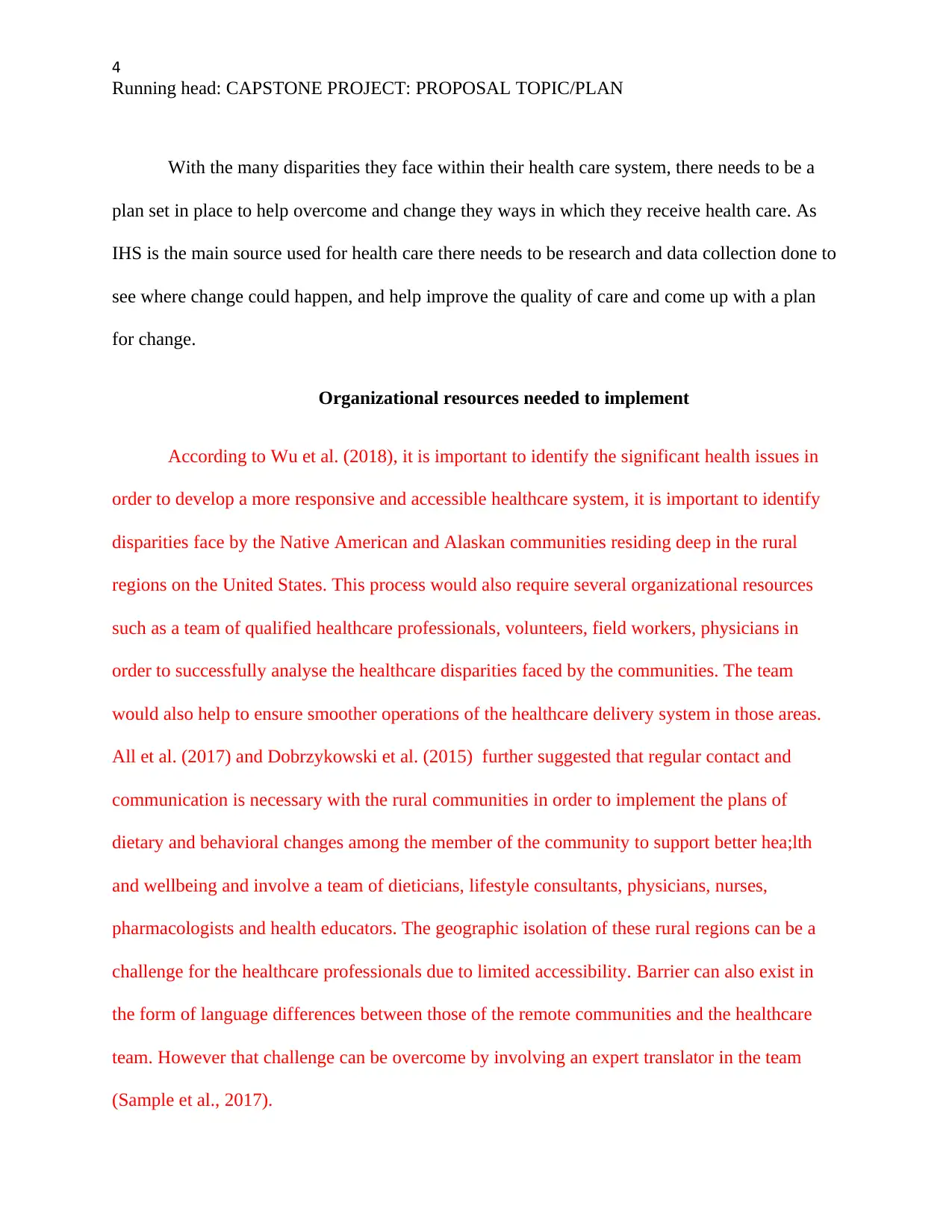
4
Running head: CAPSTONE PROJECT: PROPOSAL TOPIC/PLAN
With the many disparities they face within their health care system, there needs to be a
plan set in place to help overcome and change they ways in which they receive health care. As
IHS is the main source used for health care there needs to be research and data collection done to
see where change could happen, and help improve the quality of care and come up with a plan
for change.
Organizational resources needed to implement
According to Wu et al. (2018), it is important to identify the significant health issues in
order to develop a more responsive and accessible healthcare system, it is important to identify
disparities face by the Native American and Alaskan communities residing deep in the rural
regions on the United States. This process would also require several organizational resources
such as a team of qualified healthcare professionals, volunteers, field workers, physicians in
order to successfully analyse the healthcare disparities faced by the communities. The team
would also help to ensure smoother operations of the healthcare delivery system in those areas.
All et al. (2017) and Dobrzykowski et al. (2015) further suggested that regular contact and
communication is necessary with the rural communities in order to implement the plans of
dietary and behavioral changes among the member of the community to support better hea;lth
and wellbeing and involve a team of dieticians, lifestyle consultants, physicians, nurses,
pharmacologists and health educators. The geographic isolation of these rural regions can be a
challenge for the healthcare professionals due to limited accessibility. Barrier can also exist in
the form of language differences between those of the remote communities and the healthcare
team. However that challenge can be overcome by involving an expert translator in the team
(Sample et al., 2017).
Running head: CAPSTONE PROJECT: PROPOSAL TOPIC/PLAN
With the many disparities they face within their health care system, there needs to be a
plan set in place to help overcome and change they ways in which they receive health care. As
IHS is the main source used for health care there needs to be research and data collection done to
see where change could happen, and help improve the quality of care and come up with a plan
for change.
Organizational resources needed to implement
According to Wu et al. (2018), it is important to identify the significant health issues in
order to develop a more responsive and accessible healthcare system, it is important to identify
disparities face by the Native American and Alaskan communities residing deep in the rural
regions on the United States. This process would also require several organizational resources
such as a team of qualified healthcare professionals, volunteers, field workers, physicians in
order to successfully analyse the healthcare disparities faced by the communities. The team
would also help to ensure smoother operations of the healthcare delivery system in those areas.
All et al. (2017) and Dobrzykowski et al. (2015) further suggested that regular contact and
communication is necessary with the rural communities in order to implement the plans of
dietary and behavioral changes among the member of the community to support better hea;lth
and wellbeing and involve a team of dieticians, lifestyle consultants, physicians, nurses,
pharmacologists and health educators. The geographic isolation of these rural regions can be a
challenge for the healthcare professionals due to limited accessibility. Barrier can also exist in
the form of language differences between those of the remote communities and the healthcare
team. However that challenge can be overcome by involving an expert translator in the team
(Sample et al., 2017).
Paraphrase This Document
Need a fresh take? Get an instant paraphrase of this document with our AI Paraphraser
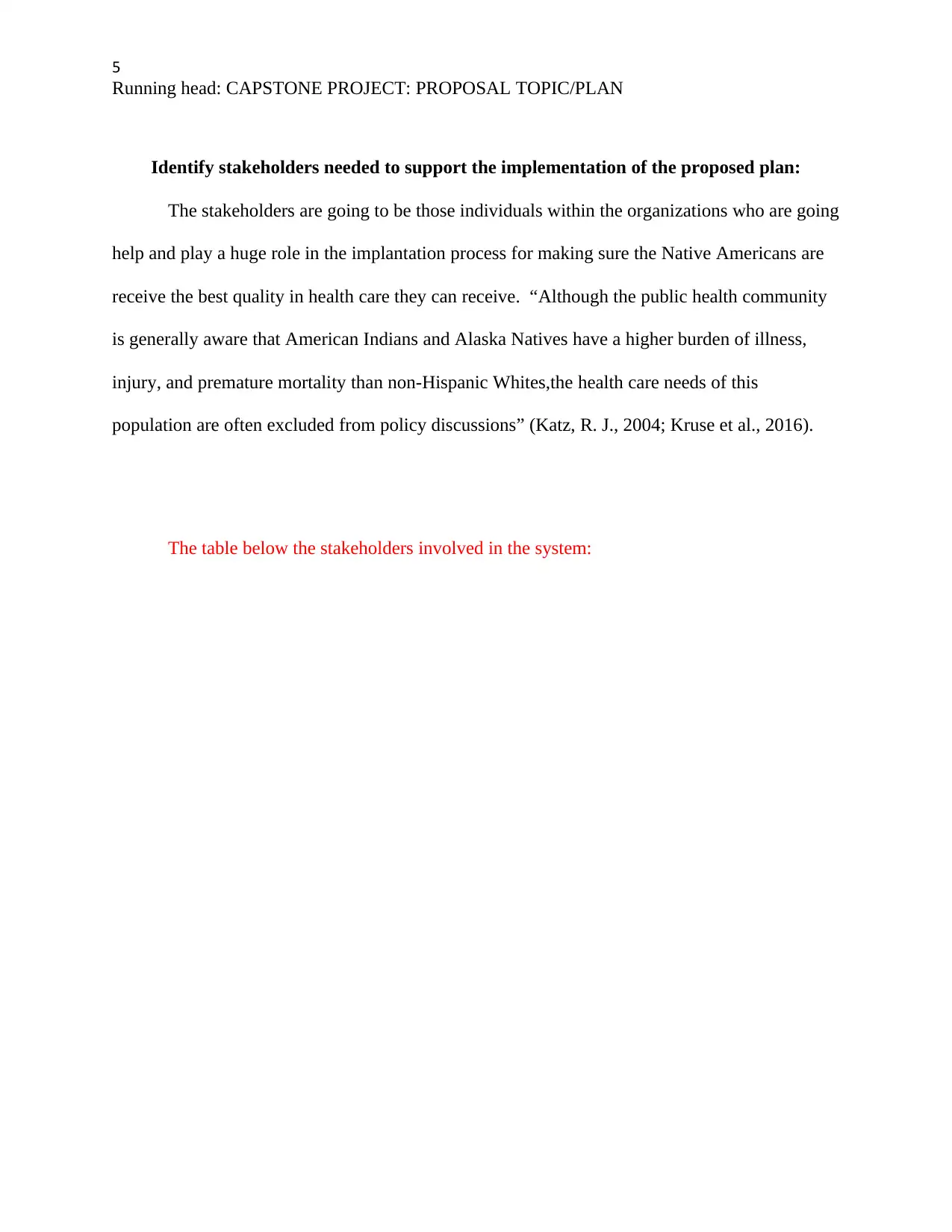
5
Running head: CAPSTONE PROJECT: PROPOSAL TOPIC/PLAN
Identify stakeholders needed to support the implementation of the proposed plan:
The stakeholders are going to be those individuals within the organizations who are going
help and play a huge role in the implantation process for making sure the Native Americans are
receive the best quality in health care they can receive. “Although the public health community
is generally aware that American Indians and Alaska Natives have a higher burden of illness,
injury, and premature mortality than non-Hispanic Whites,the health care needs of this
population are often excluded from policy discussions” (Katz, R. J., 2004; Kruse et al., 2016).
The table below the stakeholders involved in the system:
StakeholdersPrimaryhealthcarephysiciansHealthcareprofessionalsNativecommunitiesTribalGovernment
Running head: CAPSTONE PROJECT: PROPOSAL TOPIC/PLAN
Identify stakeholders needed to support the implementation of the proposed plan:
The stakeholders are going to be those individuals within the organizations who are going
help and play a huge role in the implantation process for making sure the Native Americans are
receive the best quality in health care they can receive. “Although the public health community
is generally aware that American Indians and Alaska Natives have a higher burden of illness,
injury, and premature mortality than non-Hispanic Whites,the health care needs of this
population are often excluded from policy discussions” (Katz, R. J., 2004; Kruse et al., 2016).
The table below the stakeholders involved in the system:
StakeholdersPrimaryhealthcarephysiciansHealthcareprofessionalsNativecommunitiesTribalGovernment
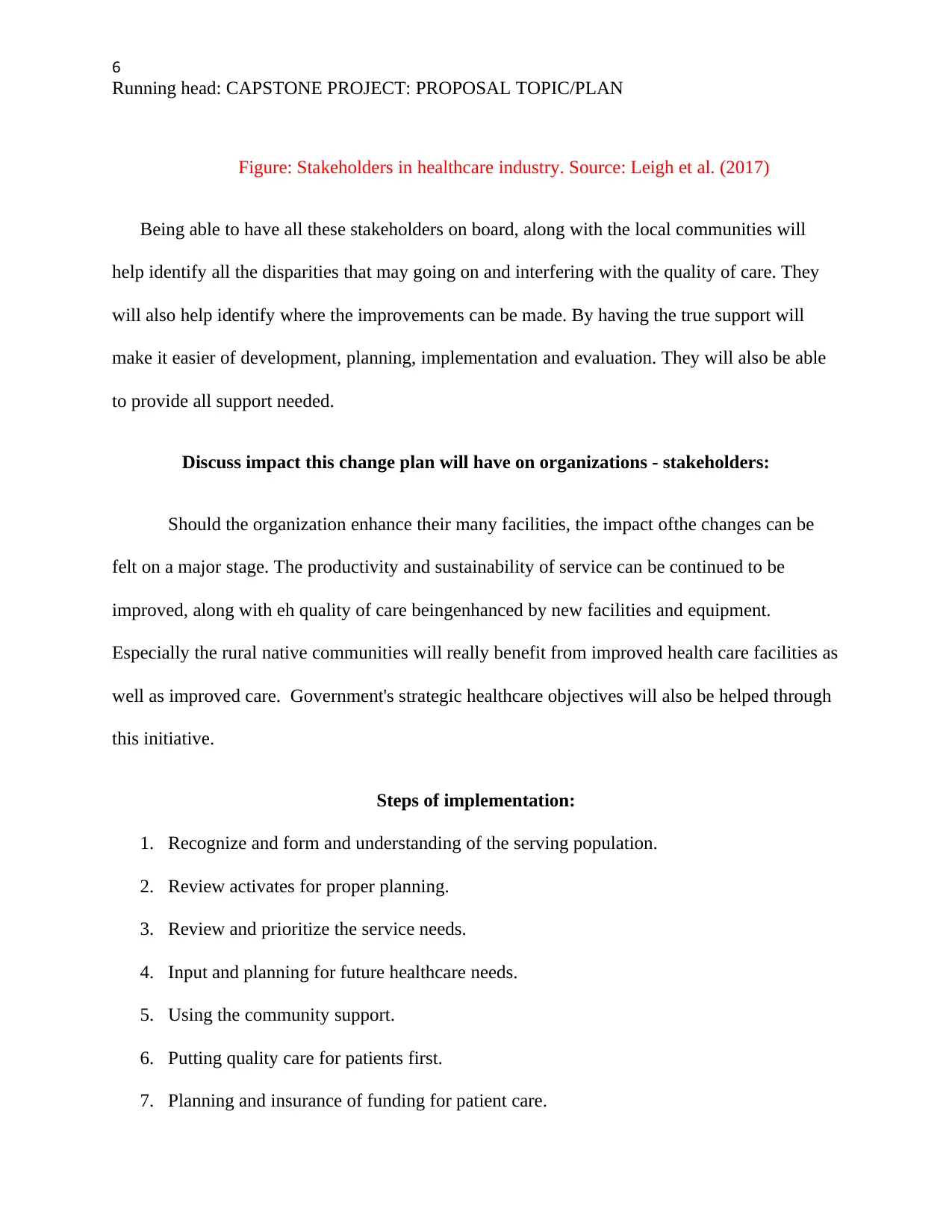
6
Running head: CAPSTONE PROJECT: PROPOSAL TOPIC/PLAN
Figure: Stakeholders in healthcare industry. Source: Leigh et al. (2017)
Being able to have all these stakeholders on board, along with the local communities will
help identify all the disparities that may going on and interfering with the quality of care. They
will also help identify where the improvements can be made. By having the true support will
make it easier of development, planning, implementation and evaluation. They will also be able
to provide all support needed.
Discuss impact this change plan will have on organizations - stakeholders:
Should the organization enhance their many facilities, the impact ofthe changes can be
felt on a major stage. The productivity and sustainability of service can be continued to be
improved, along with eh quality of care beingenhanced by new facilities and equipment.
Especially the rural native communities will really benefit from improved health care facilities as
well as improved care. Government's strategic healthcare objectives will also be helped through
this initiative.
Steps of implementation:
1. Recognize and form and understanding of the serving population.
2. Review activates for proper planning.
3. Review and prioritize the service needs.
4. Input and planning for future healthcare needs.
5. Using the community support.
6. Putting quality care for patients first.
7. Planning and insurance of funding for patient care.
Running head: CAPSTONE PROJECT: PROPOSAL TOPIC/PLAN
Figure: Stakeholders in healthcare industry. Source: Leigh et al. (2017)
Being able to have all these stakeholders on board, along with the local communities will
help identify all the disparities that may going on and interfering with the quality of care. They
will also help identify where the improvements can be made. By having the true support will
make it easier of development, planning, implementation and evaluation. They will also be able
to provide all support needed.
Discuss impact this change plan will have on organizations - stakeholders:
Should the organization enhance their many facilities, the impact ofthe changes can be
felt on a major stage. The productivity and sustainability of service can be continued to be
improved, along with eh quality of care beingenhanced by new facilities and equipment.
Especially the rural native communities will really benefit from improved health care facilities as
well as improved care. Government's strategic healthcare objectives will also be helped through
this initiative.
Steps of implementation:
1. Recognize and form and understanding of the serving population.
2. Review activates for proper planning.
3. Review and prioritize the service needs.
4. Input and planning for future healthcare needs.
5. Using the community support.
6. Putting quality care for patients first.
7. Planning and insurance of funding for patient care.
⊘ This is a preview!⊘
Do you want full access?
Subscribe today to unlock all pages.

Trusted by 1+ million students worldwide
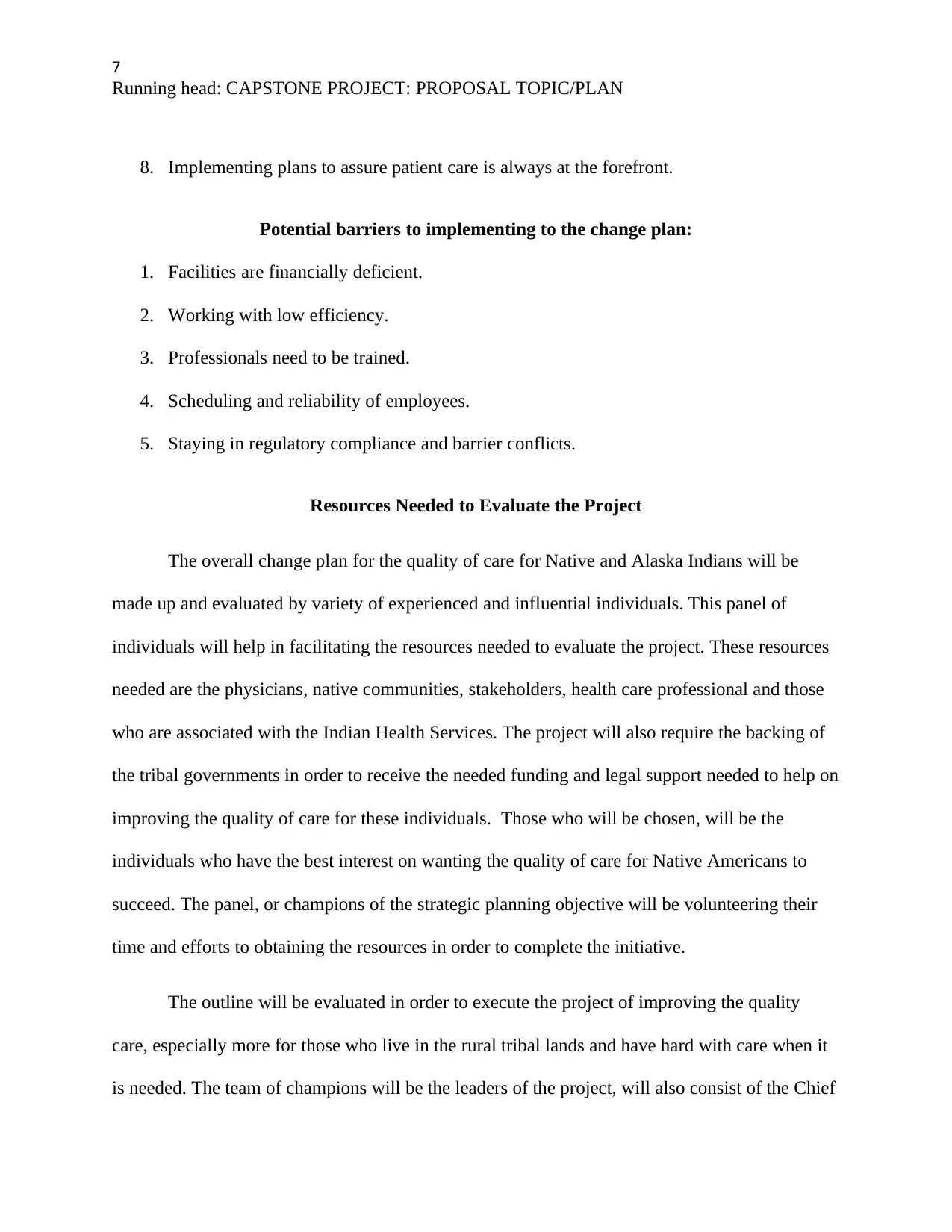
7
Running head: CAPSTONE PROJECT: PROPOSAL TOPIC/PLAN
8. Implementing plans to assure patient care is always at the forefront.
Potential barriers to implementing to the change plan:
1. Facilities are financially deficient.
2. Working with low efficiency.
3. Professionals need to be trained.
4. Scheduling and reliability of employees.
5. Staying in regulatory compliance and barrier conflicts.
Resources Needed to Evaluate the Project
The overall change plan for the quality of care for Native and Alaska Indians will be
made up and evaluated by variety of experienced and influential individuals. This panel of
individuals will help in facilitating the resources needed to evaluate the project. These resources
needed are the physicians, native communities, stakeholders, health care professional and those
who are associated with the Indian Health Services. The project will also require the backing of
the tribal governments in order to receive the needed funding and legal support needed to help on
improving the quality of care for these individuals. Those who will be chosen, will be the
individuals who have the best interest on wanting the quality of care for Native Americans to
succeed. The panel, or champions of the strategic planning objective will be volunteering their
time and efforts to obtaining the resources in order to complete the initiative.
The outline will be evaluated in order to execute the project of improving the quality
care, especially more for those who live in the rural tribal lands and have hard with care when it
is needed. The team of champions will be the leaders of the project, will also consist of the Chief
Running head: CAPSTONE PROJECT: PROPOSAL TOPIC/PLAN
8. Implementing plans to assure patient care is always at the forefront.
Potential barriers to implementing to the change plan:
1. Facilities are financially deficient.
2. Working with low efficiency.
3. Professionals need to be trained.
4. Scheduling and reliability of employees.
5. Staying in regulatory compliance and barrier conflicts.
Resources Needed to Evaluate the Project
The overall change plan for the quality of care for Native and Alaska Indians will be
made up and evaluated by variety of experienced and influential individuals. This panel of
individuals will help in facilitating the resources needed to evaluate the project. These resources
needed are the physicians, native communities, stakeholders, health care professional and those
who are associated with the Indian Health Services. The project will also require the backing of
the tribal governments in order to receive the needed funding and legal support needed to help on
improving the quality of care for these individuals. Those who will be chosen, will be the
individuals who have the best interest on wanting the quality of care for Native Americans to
succeed. The panel, or champions of the strategic planning objective will be volunteering their
time and efforts to obtaining the resources in order to complete the initiative.
The outline will be evaluated in order to execute the project of improving the quality
care, especially more for those who live in the rural tribal lands and have hard with care when it
is needed. The team of champions will be the leaders of the project, will also consist of the Chief
Paraphrase This Document
Need a fresh take? Get an instant paraphrase of this document with our AI Paraphraser
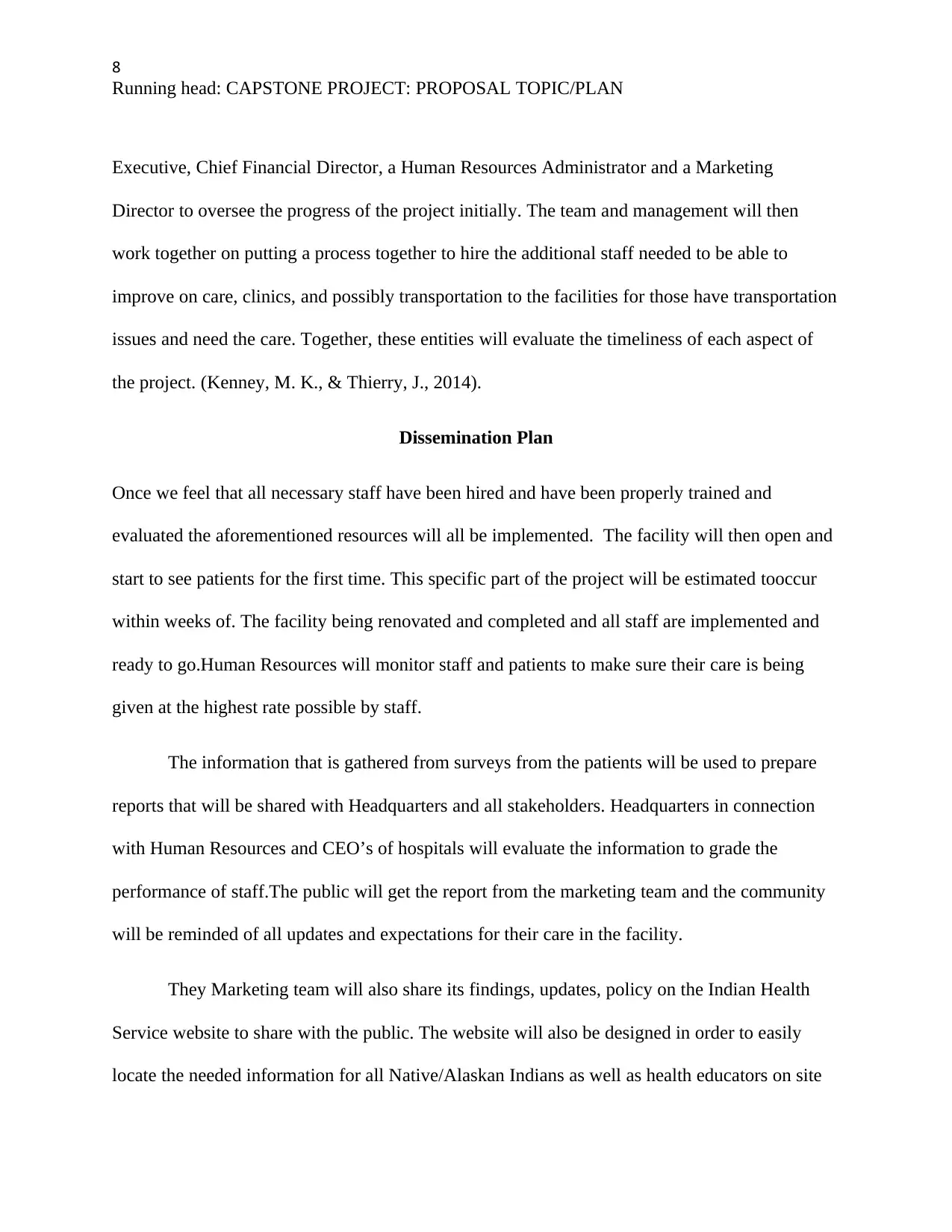
8
Running head: CAPSTONE PROJECT: PROPOSAL TOPIC/PLAN
Executive, Chief Financial Director, a Human Resources Administrator and a Marketing
Director to oversee the progress of the project initially. The team and management will then
work together on putting a process together to hire the additional staff needed to be able to
improve on care, clinics, and possibly transportation to the facilities for those have transportation
issues and need the care. Together, these entities will evaluate the timeliness of each aspect of
the project. (Kenney, M. K., & Thierry, J., 2014).
Dissemination Plan
Once we feel that all necessary staff have been hired and have been properly trained and
evaluated the aforementioned resources will all be implemented. The facility will then open and
start to see patients for the first time. This specific part of the project will be estimated tooccur
within weeks of. The facility being renovated and completed and all staff are implemented and
ready to go.Human Resources will monitor staff and patients to make sure their care is being
given at the highest rate possible by staff.
The information that is gathered from surveys from the patients will be used to prepare
reports that will be shared with Headquarters and all stakeholders. Headquarters in connection
with Human Resources and CEO’s of hospitals will evaluate the information to grade the
performance of staff.The public will get the report from the marketing team and the community
will be reminded of all updates and expectations for their care in the facility.
They Marketing team will also share its findings, updates, policy on the Indian Health
Service website to share with the public. The website will also be designed in order to easily
locate the needed information for all Native/Alaskan Indians as well as health educators on site
Running head: CAPSTONE PROJECT: PROPOSAL TOPIC/PLAN
Executive, Chief Financial Director, a Human Resources Administrator and a Marketing
Director to oversee the progress of the project initially. The team and management will then
work together on putting a process together to hire the additional staff needed to be able to
improve on care, clinics, and possibly transportation to the facilities for those have transportation
issues and need the care. Together, these entities will evaluate the timeliness of each aspect of
the project. (Kenney, M. K., & Thierry, J., 2014).
Dissemination Plan
Once we feel that all necessary staff have been hired and have been properly trained and
evaluated the aforementioned resources will all be implemented. The facility will then open and
start to see patients for the first time. This specific part of the project will be estimated tooccur
within weeks of. The facility being renovated and completed and all staff are implemented and
ready to go.Human Resources will monitor staff and patients to make sure their care is being
given at the highest rate possible by staff.
The information that is gathered from surveys from the patients will be used to prepare
reports that will be shared with Headquarters and all stakeholders. Headquarters in connection
with Human Resources and CEO’s of hospitals will evaluate the information to grade the
performance of staff.The public will get the report from the marketing team and the community
will be reminded of all updates and expectations for their care in the facility.
They Marketing team will also share its findings, updates, policy on the Indian Health
Service website to share with the public. The website will also be designed in order to easily
locate the needed information for all Native/Alaskan Indians as well as health educators on site
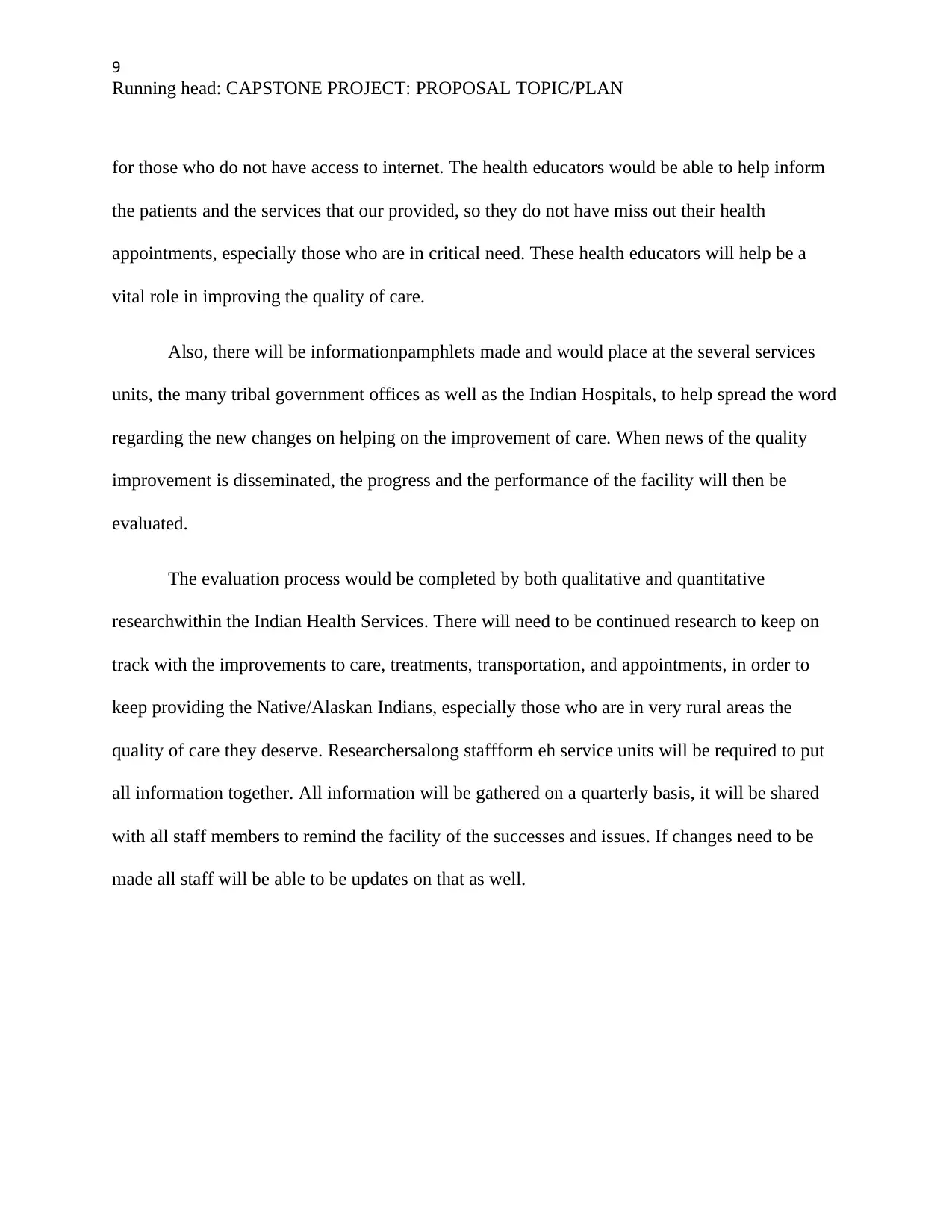
9
Running head: CAPSTONE PROJECT: PROPOSAL TOPIC/PLAN
for those who do not have access to internet. The health educators would be able to help inform
the patients and the services that our provided, so they do not have miss out their health
appointments, especially those who are in critical need. These health educators will help be a
vital role in improving the quality of care.
Also, there will be informationpamphlets made and would place at the several services
units, the many tribal government offices as well as the Indian Hospitals, to help spread the word
regarding the new changes on helping on the improvement of care. When news of the quality
improvement is disseminated, the progress and the performance of the facility will then be
evaluated.
The evaluation process would be completed by both qualitative and quantitative
researchwithin the Indian Health Services. There will need to be continued research to keep on
track with the improvements to care, treatments, transportation, and appointments, in order to
keep providing the Native/Alaskan Indians, especially those who are in very rural areas the
quality of care they deserve. Researchersalong staffform eh service units will be required to put
all information together. All information will be gathered on a quarterly basis, it will be shared
with all staff members to remind the facility of the successes and issues. If changes need to be
made all staff will be able to be updates on that as well.
Running head: CAPSTONE PROJECT: PROPOSAL TOPIC/PLAN
for those who do not have access to internet. The health educators would be able to help inform
the patients and the services that our provided, so they do not have miss out their health
appointments, especially those who are in critical need. These health educators will help be a
vital role in improving the quality of care.
Also, there will be informationpamphlets made and would place at the several services
units, the many tribal government offices as well as the Indian Hospitals, to help spread the word
regarding the new changes on helping on the improvement of care. When news of the quality
improvement is disseminated, the progress and the performance of the facility will then be
evaluated.
The evaluation process would be completed by both qualitative and quantitative
researchwithin the Indian Health Services. There will need to be continued research to keep on
track with the improvements to care, treatments, transportation, and appointments, in order to
keep providing the Native/Alaskan Indians, especially those who are in very rural areas the
quality of care they deserve. Researchersalong staffform eh service units will be required to put
all information together. All information will be gathered on a quarterly basis, it will be shared
with all staff members to remind the facility of the successes and issues. If changes need to be
made all staff will be able to be updates on that as well.
⊘ This is a preview!⊘
Do you want full access?
Subscribe today to unlock all pages.

Trusted by 1+ million students worldwide

10
Running head: CAPSTONE PROJECT: PROPOSAL TOPIC/PLAN
Running head: CAPSTONE PROJECT: PROPOSAL TOPIC/PLAN
Paraphrase This Document
Need a fresh take? Get an instant paraphrase of this document with our AI Paraphraser
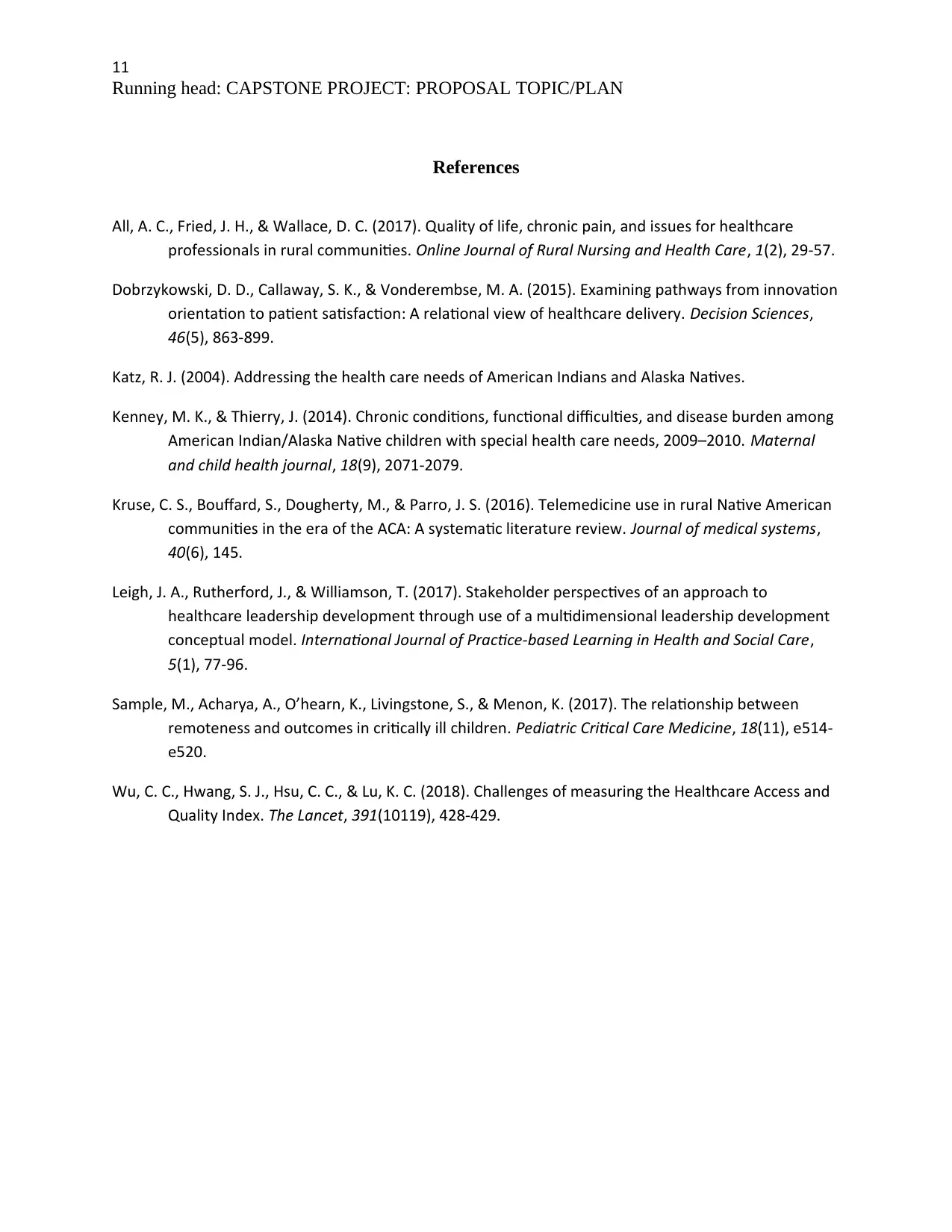
11
Running head: CAPSTONE PROJECT: PROPOSAL TOPIC/PLAN
References
All, A. C., Fried, J. H., & Wallace, D. C. (2017). Quality of life, chronic pain, and issues for healthcare
professionals in rural communities. Online Journal of Rural Nursing and Health Care, 1(2), 29-57.
Dobrzykowski, D. D., Callaway, S. K., & Vonderembse, M. A. (2015). Examining pathways from innovation
orientation to patient satisfaction: A relational view of healthcare delivery. Decision Sciences,
46(5), 863-899.
Katz, R. J. (2004). Addressing the health care needs of American Indians and Alaska Natives.
Kenney, M. K., & Thierry, J. (2014). Chronic conditions, functional difficulties, and disease burden among
American Indian/Alaska Native children with special health care needs, 2009–2010. Maternal
and child health journal, 18(9), 2071-2079.
Kruse, C. S., Bouffard, S., Dougherty, M., & Parro, J. S. (2016). Telemedicine use in rural Native American
communities in the era of the ACA: A systematic literature review. Journal of medical systems,
40(6), 145.
Leigh, J. A., Rutherford, J., & Williamson, T. (2017). Stakeholder perspectives of an approach to
healthcare leadership development through use of a multidimensional leadership development
conceptual model. International Journal of Practice-based Learning in Health and Social Care,
5(1), 77-96.
Sample, M., Acharya, A., O’hearn, K., Livingstone, S., & Menon, K. (2017). The relationship between
remoteness and outcomes in critically ill children. Pediatric Critical Care Medicine, 18(11), e514-
e520.
Wu, C. C., Hwang, S. J., Hsu, C. C., & Lu, K. C. (2018). Challenges of measuring the Healthcare Access and
Quality Index. The Lancet, 391(10119), 428-429.
Running head: CAPSTONE PROJECT: PROPOSAL TOPIC/PLAN
References
All, A. C., Fried, J. H., & Wallace, D. C. (2017). Quality of life, chronic pain, and issues for healthcare
professionals in rural communities. Online Journal of Rural Nursing and Health Care, 1(2), 29-57.
Dobrzykowski, D. D., Callaway, S. K., & Vonderembse, M. A. (2015). Examining pathways from innovation
orientation to patient satisfaction: A relational view of healthcare delivery. Decision Sciences,
46(5), 863-899.
Katz, R. J. (2004). Addressing the health care needs of American Indians and Alaska Natives.
Kenney, M. K., & Thierry, J. (2014). Chronic conditions, functional difficulties, and disease burden among
American Indian/Alaska Native children with special health care needs, 2009–2010. Maternal
and child health journal, 18(9), 2071-2079.
Kruse, C. S., Bouffard, S., Dougherty, M., & Parro, J. S. (2016). Telemedicine use in rural Native American
communities in the era of the ACA: A systematic literature review. Journal of medical systems,
40(6), 145.
Leigh, J. A., Rutherford, J., & Williamson, T. (2017). Stakeholder perspectives of an approach to
healthcare leadership development through use of a multidimensional leadership development
conceptual model. International Journal of Practice-based Learning in Health and Social Care,
5(1), 77-96.
Sample, M., Acharya, A., O’hearn, K., Livingstone, S., & Menon, K. (2017). The relationship between
remoteness and outcomes in critically ill children. Pediatric Critical Care Medicine, 18(11), e514-
e520.
Wu, C. C., Hwang, S. J., Hsu, C. C., & Lu, K. C. (2018). Challenges of measuring the Healthcare Access and
Quality Index. The Lancet, 391(10119), 428-429.
1 out of 11
Your All-in-One AI-Powered Toolkit for Academic Success.
+13062052269
info@desklib.com
Available 24*7 on WhatsApp / Email
![[object Object]](/_next/static/media/star-bottom.7253800d.svg)
Unlock your academic potential
Copyright © 2020–2025 A2Z Services. All Rights Reserved. Developed and managed by ZUCOL.


